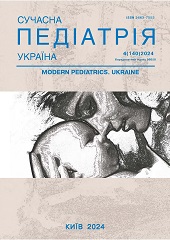Eosinophilic leukemoid reaction in a child with mixed helminthiasis
DOI:
https://doi.org/10.15574/SP.2024.140.131Keywords:
leukemoid reaction, mixed helminthiasis, toxocariasis, ascariasis, trichinellosis, childrenAbstract
Leukemoid reactions (LR) are changes in the blood and hematopoietic organs that resemble leukemias and other tumors of the hematopoietic system, but are always reactive in nature and do not transform into cancer. Viruses, toxins of tissue helminths, biologically active substances that are released during erythrocytes hemolysis, immune, allergic processes, and sepsis play an etiological role in the LR development. In such cases hematopoietic cell hyperplasia is possible with a normal ratio of elements in the bone marrow.
The aim is to familiarize doctors using a clinical case as the example with the diagnosis and treatment of mixed helminthiasis complicated by eosinophilic LR in a child.
A clinical case of the eosinophilic leukemoid reaction in a child with mixed helminthiasis: toxocarosis, trichinellosis, ascariasis is described. 8 years old boy was admitted to the infectious diseases hospital on the 13th day of illness with complaints of increased body temperature up to 39.0-39.5°C, body ache. Before admission the child was examined by a pediatrician and diagnosed with acute respiratory disease: tonsillopharyngitis. The precriptions included antibiotic therapy and non-steroidal anti-inflammatory drugs, positive dynamics was absent. Toxocarosis, trichinellosis and ascariasis were diagnosed in the infectious diseases hospital, antihelmintic and symptomatic therapy was prescribed. However, the child's condition did not improve, leukocytosis and eosinophilia increased in the blood. In order to rule out a neoplastic process, the child underwent a bone marrow puncture, and no signs characteristic of leukemia were detected. Glucocorticoids and antihistamines were prescribed, against the background of which positive clinical and laboratory dynamics were observed.
Conclusions. The presented clinical case demonstrates the need for careful analysis of clinical, anamnestic, epidemiological and objective examination data for the diagnosis of helminthiasis. In the presence of hypereosinophilia, it is important to do differential diagnose of its causes namely tumors, infectious and rheumatological diseases, allergic and atopic conditions, parasitosis. Such patients always require a multidisciplinary approach during diagnosis and treatment.
The research was carried out in accordance with the principles of the Helsinki Declaration. Informed consent of the child's parents was obtained for the research.
The authors declare no conflict of interest.
References
Dorosh OI, Dudash PJ, Cesaro S, Petronchak OA et al. (2019). Leukemoid reactions and chronic chronic myeloproliferative diseases in children: similarity and differences. Modern Pediatrics.Ukraine. 5(101): 9-30. https://doi.org/10.15574/SP.2019.101.9
Hoofien A, Yarden-Bilavski H, Ashkenazi S et al. (2018). Leukemoid reaction in the pediatric population: etiologies, outcome, and implications. Eur J Pediatr. 177: 1029-1036. https://doi.org/10.1007/s00431-018-3155-5; PMid:29696475
Kramarov SO, Zakordonets LV. (2019). Likuvannia helmintoziv. Suchasnyi pohliad na problemu. Aktualna infektolohiia. 7(5): 252-258. https://doi.org/10.22141/2312-413x.7.5.2019.183704
Ponochevna OV, Okhotnikova OM. (2018). Syndrom hipereozynofilii: suchasna sutnist, rozmaittia prychyn, skladnist diahnostyky i vyboru terapii. Klinichna imunolohiia. Alerholohiia. Infektolohiia. 7(112): 24-31.
Portich JP, Faulhaber GAM. (2019). Leukemoid reaction: A 21st-century cohort study. Int J Lab Hematol. 00: 1-6. https://doi.org/10.1111/ijlh.13127; PMid:31765058
Pryshliak OY, Protsyk AL, Semaniv MV, Boichuk OP, Gerych PR. (2022). Effect of probiotics on the intestinal microbiota of patients with giardiasis and ascariasis. Journal of medicine and life. 15(10): 1278. https://doi.org/10.25122/jml-2022-0191; PMid:36420289 PMCid:PMC9675309
Skulinova K, Novak J, Kasny M, Kolarova L. (2020). Seroprevalence of Larval Toxocarosis in the Czech Republic. Acta Parasitol. 65(1): 68-76. https://doi.org/10.2478/s11686-019-00121-0; PMid:31586285
Zakharchuk OI. (2020). Stan humoralnoi lanky imunitetu u ditei khvorykh na toksokaroz. Ukrainskyi zhurnal medytsyny, biolohii ta sportu. 5(4): 150-154. https://doi.org/10.26693/jmbs05.04.150
Downloads
Published
Issue
Section
License
Copyright (c) 2024 Modern pediatrics. Ukraine

This work is licensed under a Creative Commons Attribution-NonCommercial 4.0 International License.
The policy of the Journal “MODERN PEDIATRICS. UKRAINE” is compatible with the vast majority of funders' of open access and self-archiving policies. The journal provides immediate open access route being convinced that everyone – not only scientists - can benefit from research results, and publishes articles exclusively under open access distribution, with a Creative Commons Attribution-Noncommercial 4.0 international license (СС BY-NC).
Authors transfer the copyright to the Journal “MODERN PEDIATRICS. UKRAINE” when the manuscript is accepted for publication. Authors declare that this manuscript has not been published nor is under simultaneous consideration for publication elsewhere. After publication, the articles become freely available on-line to the public.
Readers have the right to use, distribute, and reproduce articles in any medium, provided the articles and the journal are properly cited.
The use of published materials for commercial purposes is strongly prohibited.

